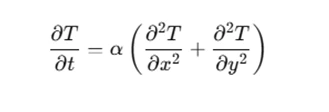How to Solve 2D Heat Diffusion Assignments Using MATLAB

In engineering and physics, heat transfer plays a critical role in understanding the behavior of materials under different thermal conditions. A common problem students encounter is solving the 2D heat diffusion equation for a physical system like a rectangular fin. This type of problem is frequently encountered in assignments, especially for students studying thermodynamics, fluid mechanics, and heat transfer.
In this blog, we will provide a detailed guide for solving 2D heat diffusion problems using MATLAB, specifically tailored to assignments similar to those involving heat transfer through a rectangular fin. We will walk you through setting up the problem, applying numerical methods like the explicit method and ADI (Alternating Direction Implicit) method, and understanding how to visualize the temperature distribution over time. We’ll also discuss some of the important considerations that come with stability and validation of your results.

Understanding the Problem
Let’s first understand the background of the problem. Consider a long rectangular fin attached to a heat source. The fin is much longer in one direction (into the page) than in the other, so heat flow is primarily two-dimensional. The left side of the fin is subjected to a constant base temperature of 100°C, while the other three sides experience convection to a surrounding air environment at 25°C.
The temperature distribution across the fin at any given time is governed by the 2D heat diffusion equation:

Where:
- T is the temperature at a given point,
- α is the thermal diffusivity,
- t is time,
- x and y are the spatial coordinates in the 2D plane.
The goal of this assignment is to calculate how the temperature evolves with time in the fin and perform several related tasks like computing the average temperature at the tip, the heat rate, and the time it takes for the system to reach steady-state conditions.
Step 1: Defining Key Parameters
Before diving into solving the heat diffusion equation numerically, it is crucial to define the problem parameters in MATLAB. These parameters include thermal properties (thermal conductivity, diffusivity), geometrical dimensions of the fin, the time frame for the simulation, and initial conditions.
% Fin properties
alpha = 10e-6; % Thermal diffusivity (m^2/s)
kcond = 10; % Thermal conductivity (W/m K)
h = 50; % Convection coefficient (W/m^2 K)
% Geometric dimensions
dx = 0.001; % Node spacing in x-direction (m)
dy = dx; % Node spacing in y-direction (m)
Lx = 0.04; % Fin length in x-direction (m)
Ly = 0.01; % Fin length in y-direction (m)
% Time parameters
t0 = 0; tf = 10 * 60; % Initial and final time (seconds)
Nt = 6000; % Number of time steps
dt = (tf - t0) / Nt; % Time step size (seconds)
% Initial conditions
T = zeros(Nx, Ny, Nt+1); % Temperature matrix
T(:,:,1) = 40; % Initial temperature (°C)
Tb = 100; % Base temperature (°C)
Tinf = 25; % Free-stream temperature (°C)
These initializations define the thermal properties (such as the thermal diffusivity α, thermal conductivity kcond, and convection coefficient h), the dimensions of the fin, and the simulation time span.
Step 2: Choosing a Numerical Method
To solve the heat diffusion equation, we rely on numerical methods because the analytical solution to this equation is typically difficult to obtain in most real-world scenarios. There are two primary numerical methods to solve the 2D heat diffusion problem: the explicit method and the ADI (Alternating Direction Implicit) method.
2.1 Explicit Method
The explicit method is the simpler of the two methods. It is based on calculating the temperature at each grid point at the next time step by considering the surrounding grid points at the current time step. The formula to calculate the temperature at each point is as follows:

2.2 Stability Condition for Explicit Method
For the explicit method to work without instability, a stability criterion must be satisfied. The stability condition is given by:

If this condition is violated, the solution will become unstable and produce physically unrealistic results. You can adjust the time step dtdtdt or spatial grid spacing dxdxdx to ensure that the solution remains stable.
2.3 ADI Method
The ADI method, on the other hand, is more complex but offers better stability for larger time steps. It alternates between solving for the horizontal and vertical directions, which helps improve the solution's accuracy and stability. However, implementing ADI requires more advanced linear algebra operations, such as solving tridiagonal matrices.
Step 3: Solving the Heat Diffusion Equation
Once the numerical method is selected, the next step is solving the heat diffusion equation. The idea is to iterate over time steps, updating the temperature distribution at each grid point. For the explicit method, the algorithm follows these steps:
- Set the initial temperature distribution.
- For each time step, update the temperature at each grid point based on its neighbors.
- Repeat until the simulation reaches the final time step.
Here’s how the update is performed in MATLAB:
for t = 2:Nt+1
for i = 2:Nx-1
for j = 2:Ny-1
T(i,j,t) = T(i,j,t-1) + lambda * (T(i+1,j,t-1) + T(i-1,j,t-1) + T(i,j+1,t-1) + T(i,j-1,t-1) - 4*T(i,j,t-1));
end
end
end
Step 4: Calculating the Heat Rate and Average Temperature
After the simulation has completed, we need to compute the heat rate into the fin and the average temperature at the tip of the fin. These are important outputs that tell us how much heat has been transferred into the fin and the thermal state at its boundary.
To calculate the heat rate at the tip, you can use Fourier's Law for heat conduction:

At the fin’s tip, this becomes:
Qfinsim = kcond * (T(1, 1, Nt+1) - Tinf) * dx * dy;
The average temperature at the tip is calculated as the mean temperature of the grid points at the tip, i.e., the last row or column of your temperature matrix.
At the fin’s tip, this becomes:
Ttipsim = mean(T(end, :, Nt+1));
Step 5: Visualization with Animation
One of the best ways to understand how the temperature evolves over time is by visualizing the data through an animation. This helps in observing how the temperature distribution stabilizes as the simulation progresses.
To animate the temperature distribution, MATLAB’s contourf function can be used. It generates filled contour plots, which can be updated at each time step. Here’s how to animate the temperature distribution:
figure;
for n = 1:100:Nt % Plot every 100th time step
contourf(x, y, T(:,:,n), 20); % Contour plot of temperature distribution
colorbar; % Add color bar
title(['Time: ', num2str(n*dt/60), ' min']); % Display time in minutes
xlabel('x (m)');
ylabel('y (m)');
drawnow;
end
This code creates a contour plot of the temperature distribution every 100 time steps and updates the plot until the final time step. The colorbar shows the temperature range, and the title updates with the time in minutes.
Step 6: Validation and Sanity Checks
Once you have completed the simulation and animation, it’s important to validate your results. There are several sanity checks you can perform:
- Stability Check: Ensure that the simulation does not blow up. If it does, reduce the time step dtdtdt or spatial grid spacing dxdxdx.
- Comparison with Theoretical Results: Compare the average temperature at the tip and heat rate with results from 1D steady-state heat conduction equations. These values should closely match.
- Steady-State Behavior: Verify that the simulation eventually reaches steady-state conditions. The temperature distribution should stop changing, and the contours should become stable.
Conclusion
Solving a 2D heat diffusion equation in MATLAB can be a challenging yet rewarding task. By following a systematic approach — defining parameters, selecting numerical methods, solving the equation, and visualizing the results — students can gain valuable insights into heat transfer and thermal behavior in real-world systems. Understanding the stability conditions, calculating important outputs like the heat rate and temperature at the tip, and creating visualizations are crucial skills for mastering heat diffusion problems.
By following this guide, you’ll be well-equipped to solve your MATLAB assignment, whether you’re working on a rectangular fin, a different geometry, or another heat diffusion problem. Happy coding!